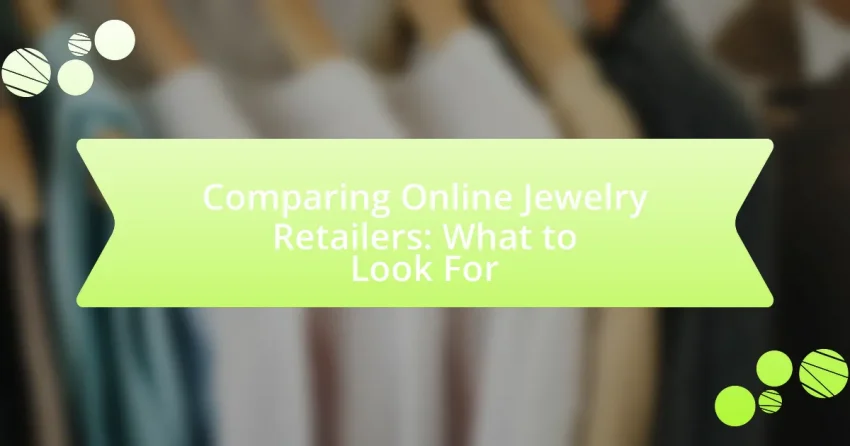The article focuses on comparing online jewelry retailers, highlighting essential factors to consider such as product quality, pricing, customer service, return policies, and shipping options. It emphasizes the importance of evaluating a retailer’s reputation through customer reviews and secure payment methods, as well as understanding the variety of jewelry types available and the significance of customization. Additionally, the article discusses pricing strategies, the impact of shipping options on purchasing decisions, and best practices for ensuring informed purchases while avoiding common pitfalls and fraudulent retailers. Overall, it serves as a comprehensive guide for consumers looking to make educated choices in the online jewelry market.

What Should You Consider When Comparing Online Jewelry Retailers?
When comparing online jewelry retailers, consider factors such as product quality, pricing, customer service, return policies, and shipping options. Product quality is essential; verify the materials used and check for certifications, such as those from the Gemological Institute of America (GIA), which ensures authenticity and value. Pricing should be competitive; compare similar items across different retailers to gauge fair market value. Customer service is crucial; look for retailers with responsive support and positive reviews, as this indicates reliability. Return policies must be clear and reasonable, allowing for exchanges or refunds if necessary. Lastly, evaluate shipping options, including costs and delivery times, to ensure a satisfactory purchasing experience.
How Do You Evaluate the Reputation of an Online Jewelry Retailer?
To evaluate the reputation of an online jewelry retailer, examine customer reviews, ratings, and return policies. Customer reviews on platforms like Trustpilot or Google Reviews provide insights into the retailer’s service quality and product satisfaction. A high average rating, typically above 4 stars, indicates positive customer experiences. Additionally, check for transparency in return policies; reputable retailers often offer hassle-free returns, which reflects confidence in their products. Furthermore, verify the retailer’s presence on social media and their engagement with customers, as active communication can signify reliability.
What Indicators Show a Retailer’s Trustworthiness?
Indicators that show a retailer’s trustworthiness include customer reviews, secure payment options, clear return policies, and visible contact information. Customer reviews provide insights into previous buyers’ experiences, with platforms like Trustpilot reporting that 79% of consumers trust online reviews as much as personal recommendations. Secure payment options, such as SSL encryption and recognized payment gateways, ensure that transactions are safe, which is crucial for consumer confidence. Clear return policies demonstrate transparency and fairness, with studies indicating that 67% of shoppers check return policies before making a purchase. Lastly, visible contact information, including a physical address and customer service phone number, reassures customers that they can reach the retailer if issues arise.
How Can Customer Reviews Influence Your Decision?
Customer reviews significantly influence purchasing decisions by providing insights into product quality and customer satisfaction. When potential buyers read reviews, they can gauge the experiences of others, which helps them assess the reliability of a retailer. Research indicates that 79% of consumers trust online reviews as much as personal recommendations, highlighting their impact on decision-making. Additionally, a study by BrightLocal found that 91% of 18-34-year-olds trust online reviews as much as personal recommendations, underscoring the importance of customer feedback in shaping perceptions of online jewelry retailers.
What Types of Jewelry Are Available from Online Retailers?
Online retailers offer a diverse range of jewelry types, including rings, necklaces, bracelets, earrings, and watches. Each category features various styles, materials, and designs, catering to different tastes and occasions. For instance, rings can range from engagement and wedding bands to fashion rings, while necklaces may include pendants, chains, and chokers. Additionally, earrings can be found in studs, hoops, and drop styles, and bracelets may vary from bangles to charm bracelets. The availability of these types of jewelry is supported by the extensive inventory of online retailers, which often includes both fine jewelry made from precious metals and gemstones, as well as costume jewelry made from alternative materials.
How Do Different Retailers Specialize in Jewelry Types?
Different retailers specialize in jewelry types by focusing on specific categories such as fine jewelry, fashion jewelry, or handmade pieces. For instance, fine jewelry retailers often emphasize high-quality materials like gold and diamonds, catering to customers seeking luxury items. In contrast, fashion jewelry retailers typically offer more affordable, trendy pieces made from less expensive materials, appealing to a broader audience. Handmade jewelry retailers focus on unique, artisanal designs, often promoting craftsmanship and individuality. This specialization allows retailers to target distinct market segments effectively, enhancing their brand identity and customer loyalty.
What Should You Know About Custom Jewelry Options?
Custom jewelry options allow individuals to create unique pieces tailored to their personal preferences and specifications. These options typically include selecting materials such as gold, silver, or platinum, choosing gemstones, and determining design elements like style and size. Customization can enhance the emotional value of jewelry, as it often represents significant life events or personal milestones. According to a survey by The Knot, 70% of couples prefer personalized engagement rings, highlighting the demand for custom jewelry.
How Important Are Pricing and Discounts When Comparing Retailers?
Pricing and discounts are crucial factors when comparing retailers, particularly in the jewelry market. Retailers often use competitive pricing strategies and discounts to attract customers, influencing purchasing decisions significantly. According to a study by the National Retail Federation, 70% of consumers consider price as a primary factor when choosing where to shop. Additionally, discounts can enhance perceived value, making consumers more likely to purchase from a retailer offering a better deal. Therefore, evaluating pricing and discounts is essential for consumers seeking the best value in their jewelry purchases.
What Pricing Strategies Do Online Jewelry Retailers Use?
Online jewelry retailers commonly use several pricing strategies, including competitive pricing, psychological pricing, and discount pricing. Competitive pricing involves setting prices based on competitors’ rates to attract price-sensitive customers. For example, retailers may analyze similar products from other brands and adjust their prices accordingly to remain appealing in the market. Psychological pricing, such as pricing items at $199 instead of $200, aims to create a perception of value and affordability. Discount pricing strategies, including seasonal sales or promotional offers, incentivize purchases by temporarily lowering prices, which can lead to increased sales volume. These strategies are supported by market research indicating that consumers are influenced by perceived value and competitive positioning in their purchasing decisions.
How Can You Identify Genuine Discounts?
To identify genuine discounts, compare the discounted price to the historical pricing of the item. Genuine discounts typically reflect a significant reduction from the original price, which can be verified through price tracking tools or websites that archive historical prices. For instance, if a piece of jewelry originally priced at $500 is marked down to $300, check if the item has previously sold at or near the original price. Additionally, reputable retailers often provide transparency about their pricing history, which can further validate the authenticity of the discount.

What Are the Key Features to Look for in Online Jewelry Retailers?
Key features to look for in online jewelry retailers include a comprehensive selection of products, transparent pricing, and robust customer service. A diverse product range ensures that customers can find various styles and materials, catering to different tastes and budgets. Transparent pricing, including clear information on any additional costs such as shipping or taxes, builds trust and helps customers make informed decisions. Additionally, responsive customer service, including easy access to support via chat, email, or phone, is crucial for addressing inquiries or issues. According to a 2021 survey by the National Retail Federation, 70% of consumers prioritize customer service when shopping online, highlighting its importance in the online jewelry retail experience.
How Do Return Policies Affect Your Purchase Decision?
Return policies significantly influence purchase decisions by providing consumers with a sense of security and reducing perceived risk. When shoppers know they can return an item easily, they are more likely to complete a purchase, especially for high-value items like jewelry. Research indicates that 67% of consumers check return policies before making a purchase, highlighting their importance in the decision-making process. A lenient return policy can enhance customer satisfaction and loyalty, as it fosters trust in the retailer.
What Should You Look for in a Return Policy?
When evaluating a return policy, you should look for clarity, time frame, and conditions for returns. A clear return policy outlines the steps required to initiate a return, ensuring customers understand the process. The time frame for returns is crucial; policies that allow at least 30 days are generally considered favorable, as they provide ample time for customers to decide. Additionally, conditions such as whether items must be unworn, in original packaging, or accompanied by a receipt can significantly impact the ease of returning products. According to a 2021 survey by the National Retail Federation, 66% of consumers consider a flexible return policy essential when shopping online, highlighting the importance of these factors in customer satisfaction.
How Do Return Policies Vary Among Retailers?
Return policies vary significantly among retailers, particularly in the jewelry sector. Some retailers offer a 30-day return window, while others may extend this period to 60 or even 90 days. For instance, major online jewelry retailers like Blue Nile provide a 30-day return policy, whereas others like Zales may offer a 60-day return policy. Additionally, some retailers impose restocking fees for returned items, while others do not. According to a 2021 survey by the National Retail Federation, 66% of consumers consider return policies when making a purchase, highlighting the importance of these policies in consumer decision-making.
What Role Does Customer Service Play in Your Shopping Experience?
Customer service plays a crucial role in the shopping experience by directly influencing customer satisfaction and loyalty. Effective customer service can enhance the overall shopping journey, providing assistance with product inquiries, order tracking, and resolving issues. According to a study by Zendesk, 87% of customers believe that good customer service can lead to increased brand loyalty, highlighting its importance in retaining customers in the competitive online jewelry market.
How Can You Assess the Quality of Customer Service?
To assess the quality of customer service, evaluate response time, communication clarity, and resolution effectiveness. Response time can be measured by how quickly customer inquiries are addressed, with industry standards suggesting that responses should occur within 24 hours. Communication clarity involves the ability of representatives to convey information clearly and accurately, which can be assessed through customer feedback and satisfaction surveys. Resolution effectiveness refers to how well customer issues are resolved, often quantified by tracking the percentage of issues resolved on the first contact, with high-performing companies typically achieving rates above 70%. These metrics provide a comprehensive view of customer service quality in online jewelry retailers.
What Communication Channels Should Be Available?
Online jewelry retailers should provide multiple communication channels, including live chat, email support, and phone support. These channels facilitate immediate assistance, allowing customers to resolve inquiries quickly. Research indicates that 79% of consumers prefer live chat for its convenience and speed, while 61% appreciate email for detailed queries. Additionally, phone support remains essential, as 70% of customers value the personal touch it offers. By offering these communication channels, online jewelry retailers enhance customer satisfaction and trust, leading to increased sales and loyalty.
How Do Shipping Options Impact Your Choice of Retailer?
Shipping options significantly influence a consumer’s choice of retailer by affecting delivery speed, cost, and convenience. Retailers that offer a variety of shipping methods, such as expedited shipping or free delivery, tend to attract more customers, as studies show that 79% of consumers prefer retailers that provide free shipping options. Additionally, the availability of same-day or next-day delivery can be a decisive factor, especially for time-sensitive purchases, as 61% of shoppers are willing to pay more for faster shipping. Therefore, retailers with flexible and customer-friendly shipping options are more likely to gain a competitive edge in the online jewelry market.
What Shipping Methods Are Common Among Online Jewelry Retailers?
Common shipping methods among online jewelry retailers include standard shipping, expedited shipping, and express shipping. Standard shipping typically takes 3 to 7 business days, while expedited options can reduce delivery time to 2 to 3 business days. Express shipping often guarantees next-day delivery. Many retailers also offer free shipping on orders over a certain amount, which is a common incentive to attract customers. According to a survey by the National Retail Federation, 75% of consumers expect free shipping on online orders, highlighting its prevalence in the jewelry retail sector.
How Can Shipping Costs Affect Your Overall Purchase?
Shipping costs can significantly impact your overall purchase by increasing the total expense associated with acquiring a product. When consumers shop online, they often consider the base price of an item, but shipping fees can add a substantial amount to the final cost. For instance, a study by the National Retail Federation found that 75% of consumers factor in shipping costs when making purchasing decisions, and high shipping fees can lead to cart abandonment. Therefore, understanding shipping costs is crucial for evaluating the true price of jewelry from online retailers, as these costs can alter the perceived value and affordability of the purchase.

What Are the Best Practices for Buying Jewelry Online?
The best practices for buying jewelry online include researching the retailer, verifying certifications, reading customer reviews, and understanding return policies. Researching the retailer ensures credibility; for instance, reputable sites often display certifications from organizations like the Gemological Institute of America (GIA). Verifying certifications guarantees the authenticity of gemstones and metals, which is crucial for investment pieces. Reading customer reviews provides insights into product quality and customer service experiences, helping to avoid potential scams. Understanding return policies is essential, as it allows for returns or exchanges if the jewelry does not meet expectations, with many reputable retailers offering at least a 30-day return window.
How Can You Ensure You’re Making an Informed Purchase?
To ensure you’re making an informed purchase, research the retailer’s reputation, product details, and return policies. Start by reading customer reviews and ratings on independent platforms to gauge the retailer’s reliability. Verify product specifications, such as materials and dimensions, to ensure they meet your expectations. Additionally, check the return policy to understand your options if the item does not meet your satisfaction. According to a 2021 survey by the Better Business Bureau, 70% of consumers rely on online reviews before making a purchase, highlighting the importance of thorough research in the decision-making process.
What Research Should You Conduct Before Buying?
Before buying jewelry online, conduct research on the retailer’s reputation, product quality, and return policies. Start by checking customer reviews and ratings on platforms like Trustpilot or Google Reviews to gauge the experiences of previous buyers. Investigate the retailer’s credentials, such as membership in the Better Business Bureau or industry associations, which can indicate reliability. Additionally, examine the quality of materials used, such as the type of metal and gemstones, by looking for certifications like GIA for diamonds. Finally, review the return and exchange policies to ensure you can return the item if it does not meet your expectations. This comprehensive research helps ensure a satisfactory purchase experience.
How Can You Verify the Authenticity of Jewelry?
To verify the authenticity of jewelry, you should seek certification from reputable gemological laboratories, such as the Gemological Institute of America (GIA) or the American Gem Society (AGS). These organizations provide detailed reports that confirm the quality and authenticity of gemstones and precious metals. Additionally, examining the jewelry for hallmarks or stamps indicating metal purity, such as “925” for sterling silver or “750” for 18-karat gold, can further validate authenticity. Researching the retailer’s reputation and customer reviews also helps ensure that you are purchasing from a trustworthy source.
What Tips Can Help You Avoid Common Pitfalls When Shopping Online?
To avoid common pitfalls when shopping online, ensure you research the retailer thoroughly before making a purchase. This includes checking customer reviews, verifying the website’s security features, and confirming return policies. According to a 2021 survey by the Better Business Bureau, 70% of consumers reported that reading reviews influenced their purchasing decisions, highlighting the importance of due diligence. Additionally, using secure payment methods and being cautious of deals that seem too good to be true can further protect against fraud.
What Red Flags Should You Watch Out For?
When comparing online jewelry retailers, watch out for red flags such as lack of transparency regarding pricing and return policies. Retailers that do not clearly display their pricing structure or have vague return policies may be attempting to hide additional fees or make it difficult for customers to return unsatisfactory products. Additionally, check for poor customer reviews or ratings, as a significant number of negative reviews can indicate issues with product quality or customer service. According to a 2021 survey by BrightLocal, 87% of consumers read online reviews for local businesses, highlighting the importance of customer feedback in assessing retailer reliability. Lastly, be cautious of websites that lack secure payment options, as this can expose you to potential fraud; a secure site typically displays “https://” in the URL.
How Can You Protect Yourself from Fraudulent Retailers?
To protect yourself from fraudulent retailers, verify the retailer’s legitimacy by checking for secure payment options, customer reviews, and contact information. Secure payment options, such as PayPal or credit cards, offer buyer protection, while customer reviews on independent sites can reveal past experiences with the retailer. Additionally, legitimate retailers typically provide clear contact information, including a physical address and customer service phone number, which can be cross-checked for authenticity. According to the Better Business Bureau, over 40% of online shoppers have encountered fraudulent retailers, highlighting the importance of these verification steps.
